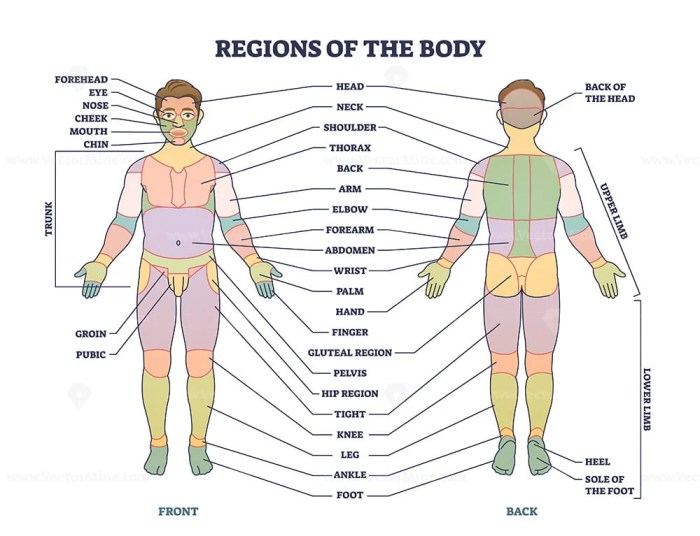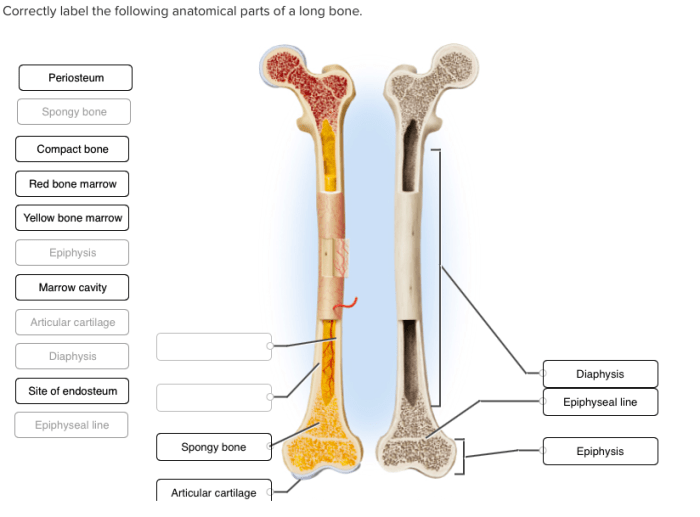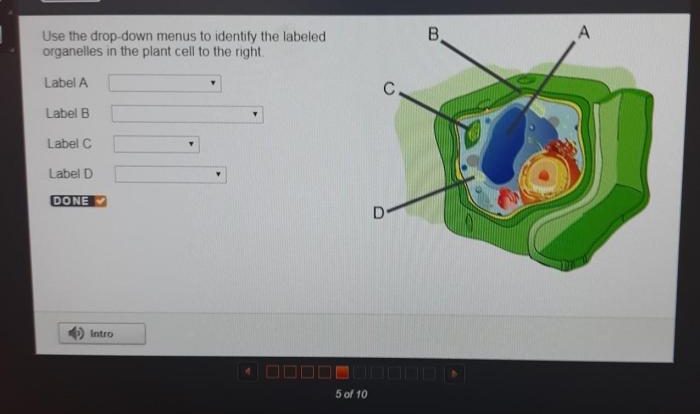Correctly label the following regions of the external anatomy – Correctly labeling the external anatomy is a crucial skill for medical professionals and students alike. It provides a foundation for understanding the human body’s structure and function, enabling accurate diagnosis and treatment. This guide will provide an in-depth overview of the external anatomy of the head, neck, trunk, upper limbs, and lower limbs, equipping readers with the knowledge to accurately identify and describe anatomical landmarks.
The human body is a complex and intricate structure, and understanding its external anatomy is essential for comprehending its overall function. By studying the external anatomy, we can gain insights into the relationships between different body parts and how they work together to maintain homeostasis.
External Anatomy of the Head

The external anatomy of the head encompasses the skull, facial bones, and associated structures. The skull provides protection for the brain and other delicate structures within the head. It consists of 22 bones, including the frontal bone, parietal bones, temporal bones, and occipital bone.
The facial bones form the framework of the face and provide support for the eyes, nose, and mouth. The major facial bones include the maxillae, zygomatic bones, nasal bones, and mandible.
Associated structures of the head include the ears, which are responsible for hearing and balance, and the eyes, which are responsible for vision.
Regions of the Head
| Region | Anatomical Features |
|---|---|
| Cranium | Frontal bone, parietal bones, temporal bones, occipital bone |
| Face | Maxillae, zygomatic bones, nasal bones, mandible |
| Ears | Auricle, external auditory canal |
| Eyes | Eyelids, eyelashes, eyebrows |
External Anatomy of the Neck
The external anatomy of the neck includes the muscles, blood vessels, nerves, and other structures. The muscles of the neck are responsible for supporting the head and facilitating movement. The major muscles of the neck include the sternocleidomastoid muscle, trapezius muscle, and platysma muscle.
The blood vessels of the neck supply blood to the head and neck. The major arteries of the neck include the carotid arteries and the vertebral arteries. The major veins of the neck include the jugular veins.
The nerves of the neck transmit sensory and motor information to and from the head and neck. The major nerves of the neck include the vagus nerve, the phrenic nerve, and the accessory nerve.
Anterior and Posterior Regions of the Neck
| Region | Anatomical Features |
|---|---|
| Anterior | Sternocleidomastoid muscle, carotid arteries, jugular veins |
| Posterior | Trapezius muscle, vertebral arteries, accessory nerve |
External Anatomy of the Trunk
The external anatomy of the trunk includes the chest, abdomen, and back. The chest is enclosed by the ribs and sternum and contains the heart and lungs. The abdomen is enclosed by the abdominal muscles and contains the stomach, intestines, and other digestive organs.
The back is supported by the vertebral column and contains the spinal cord and muscles.
The surface anatomy of the trunk can be divided into several regions, including the anterior thoracic region, the posterior thoracic region, the abdominal region, and the lumbar region.
Surface Anatomy of the Trunk, Correctly label the following regions of the external anatomy

- Anterior thoracic region: clavicles, sternum, ribs, pectoralis major muscle
- Posterior thoracic region: scapulae, vertebral column, trapezius muscle
- Abdominal region: umbilicus, abdominal muscles, inguinal canal
- Lumbar region: vertebral column, lumbar muscles
External Anatomy of the Upper Limbs

The external anatomy of the upper limbs includes the shoulder, arm, forearm, and hand. The shoulder is formed by the clavicle, scapula, and humerus. The arm is formed by the humerus. The forearm is formed by the radius and ulna.
The hand is formed by the carpal bones, metacarpal bones, and phalanges.
The muscles of the upper limbs are responsible for movement of the shoulder, arm, forearm, and hand. The major muscles of the upper limbs include the deltoid muscle, biceps brachii muscle, triceps brachii muscle, and flexor carpi radialis muscle.
The bones of the upper limbs provide support and protection for the muscles, blood vessels, and nerves of the upper limbs.
Muscles, Bones, and Joints of the Upper Limbs
| Region | Muscles | Bones | Joints |
|---|---|---|---|
| Shoulder | Deltoid muscle | Clavicle, scapula, humerus | Glenohumeral joint |
| Arm | Biceps brachii muscle, triceps brachii muscle | Humerus | Elbow joint |
| Forearm | Flexor carpi radialis muscle | Radius, ulna | Wrist joint |
| Hand | Thenar muscles, hypothenar muscles | Carpal bones, metacarpal bones, phalanges | Metacarpophalangeal joints, interphalangeal joints |
External Anatomy of the Lower Limbs

The external anatomy of the lower limbs includes the hip, thigh, leg, and foot. The hip is formed by the pelvis and the femur. The thigh is formed by the femur. The leg is formed by the tibia and fibula.
The foot is formed by the tarsal bones, metatarsal bones, and phalanges.
The muscles of the lower limbs are responsible for movement of the hip, thigh, leg, and foot. The major muscles of the lower limbs include the gluteus maximus muscle, quadriceps femoris muscle, hamstrings muscle, and gastrocnemius muscle.
The bones of the lower limbs provide support and protection for the muscles, blood vessels, and nerves of the lower limbs.
Surface Anatomy of the Lower Limbs

- Hip region: pelvis, femur, gluteus maximus muscle
- Thigh region: femur, quadriceps femoris muscle, hamstrings muscle
- Leg region: tibia, fibula, gastrocnemius muscle
- Foot region: tarsal bones, metatarsal bones, phalanges
Surface Anatomy Techniques: Correctly Label The Following Regions Of The External Anatomy
Surface anatomy techniques are used to assess the external anatomy of the body. These techniques include palpation, auscultation, and percussion.
Palpation is the use of the hands to feel the surface of the body. Palpation can be used to assess the texture, temperature, and consistency of the skin and underlying tissues. Palpation can also be used to identify anatomical landmarks and to detect abnormalities.
Auscultation is the use of a stethoscope to listen to sounds produced by the body. Auscultation can be used to assess the heart, lungs, and abdomen. Auscultation can also be used to detect abnormalities such as murmurs, wheezes, and crackles.
Percussion is the use of a finger or hammer to tap on the surface of the body. Percussion can be used to assess the density and elasticity of the underlying tissues. Percussion can also be used to detect abnormalities such as fluid accumulation and masses.
Question Bank
What is the importance of correctly labeling the external anatomy?
Correctly labeling the external anatomy is important for several reasons. First, it provides a common language for medical professionals to communicate about the human body. Second, it helps students and practitioners to visualize and understand the relationships between different body parts.
Third, it enables accurate diagnosis and treatment of medical conditions.
What are some tips for correctly labeling the external anatomy?
There are several tips that can help you to correctly label the external anatomy. First, use a standard anatomical reference guide. Second, start by identifying the major anatomical landmarks. Third, use descriptive terms to identify the location of anatomical structures.
Fourth, practice regularly.
What are some common mistakes that people make when labeling the external anatomy?
Some common mistakes that people make when labeling the external anatomy include: using incorrect anatomical terms, confusing anatomical structures, and misidentifying anatomical landmarks.
